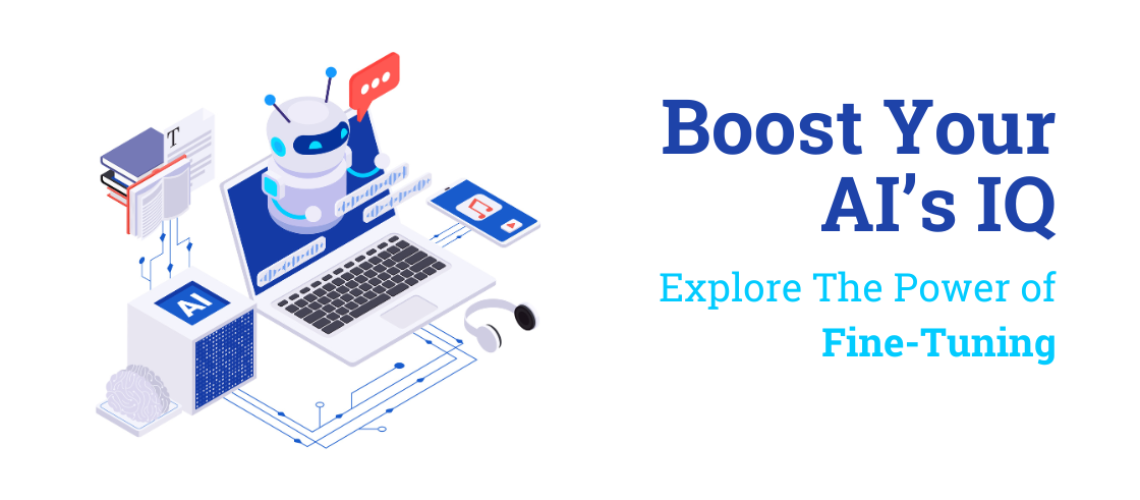As AI evolves swiftly, fine-tuning has become crucial to making AI models efficient and sophisticated for users. If you want to take complete advantage of LLM or large language models to solve problems, this blog is for you. Fine-tuning an AI means making small changes in an AI model to customize it to perform a particular use case or task. Understanding the fine-tuning process and use cases is a skill that should be engraved in every developer.
Please read the blog to understand everything about Fine-tuning an AI model and its impact on the future of tech and humans.
What is the Fine-tuning of AI?
With fine-tuning AI, one can enhance the performance of a pre-existing or pre-trained AI model by training the model on a more focused, smaller data set. The more concentrated training an AI model gets, the more refined and efficient results it will produce. This is also the most economical way to integrate AI into your projects or your automation business, as the time, data, computational power, and capital required to train such a model is much less than training a model from scratch.
Examples of Fine-tuning Tasks
- Domain Adaption: an AI model trained to recognize cancer can be trained by fine-tuning it on specific dermatological images of skin cancer or any other type of cancer that can be identified by studying the signs or symptoms.
- Performance Enhancement: A general language model like GPT-3, initially trained on a vast corpus of text, can be finetuned to generate computer code by training it further on a dataset comprising various programming languages.
- Customization for Specific Needs: A chatbot can be fine-tuned to perform customer service tasks by training it on data gathered from customer interactions. A fine-tuned AI can handle customer queries by understanding their problems with products and can also provide faster solutions by learning about the products and services.
These examples show that fine-tuning an AI model can make it versatile and practically more applicable across different industries and functions. This process tailors the broad capabilities of AI to meet the unique challenges and requirements of specific tasks, making it an invaluable tool in the arsenal of machine learning developers and researchers.
Process of Fine-tuning a Model
Initial Training on Large Dataset
Selecting a pre-trained model on a large dataset is a crucial initial step in fine-tuning. Pre-trained models broadly understand tasks like image recognition or natural language processing. With the help of pre-existing knowledge, models can provide features and perform tasks every day in many industries.
Adapting to Specialized Datasets
The next step in fine-tuning an AI is to adapt it to more specialized data. I am adjusting internal parameters to optimize performance for a specific task. The model’s maximum part remains intact, allowing it to retain the valuable features it learned during initial training while being fine-tuned for precision on a narrower dataset.
Final Adjustments and Freezing Layers
The final phase of fine-tuning involves making specific adjustments to the model’s architecture, such as modifying the top layers or altering the number of output neurons to suit the particular requirements of the task. An essential strategy during this phase is the selective freezing of layers. Freezing specific layers prevents them from updating during further training, which helps preserve the already learned general features and reduces the risk of overfitting. Typically, lower layers are frozen to retain generic features, while higher layers are adjusted to adapt to new, task-specific data.
Key Benefits of Fine-tuning
Numerous benefits of fine-tuning are critical in optimizing machine learning processes and achieving superior outcomes with existing resources. Below are some vital benefits fragmented under specific aspects:
Efficiency in Resource
Fine-tuning adapts the capabilities of pre-trained models, which ultimately reduces the time, computational power, and capital required for training a new model from scratch. This process speeds up the adaption of the model to a specific task. This efficiency is especially beneficial when computational resources are limited or rapid deployment is crucial.
Enhanced Task-Specific Performance
The primary advantage of fine-tuning is its ability to enhance the performance of AI models on specific tasks. Pre-trained models come equipped with a general understanding acquired from large datasets, which includes valuable features and patterns applicable to various tasks. These models can further hone these capabilities through fine-tuning to improve accuracy, efficiency, and output quality for specialized tasks. This is particularly evident in fields like computer vision and natural language processing, where fine-tuned models achieve remarkable precision in functions such as object detection in autonomous vehicles or nuanced language understanding in AI chatbots.
Broad Accessibility
Fine-tuning makes advanced machine learning more accessible to a broader range of users and organizations. By modifying pre-trained models, companies and developers without the resources to develop models from scratch can still deploy cutting-edge AI. This accessibility also extends to applications in various industries, allowing for the customization of AI tools to meet specific needs, such as personalized customer service or targeted data analysis. Moreover, the adaptability of fine-tuning supports a diverse set of applications, making it a versatile tool for integrating AI technology across different sectors. These benefits highlight why fine-tuning is a preferred method in the field of AI, offering a blend of efficiency, enhanced
performance, and broad usability, essential for the progressive adaptation of AI technologies in real-world applications.
Conclusion
Throughout this article, we have explored the pivotal role that fine-tuning plays in the evolution and application of AI technologies. By elucidating the process, benefits, and real-world applications of fine-tuning AI models, it’s evident that this technique is a cornerstone in leveraging the potential of pre-trained models for specific tasks. From enhancing accuracy and efficiency in various domains like healthcare, customer service, and retail to making cutting-edge AI accessible for all, the significance of fine-tuning cannot be overstated. This approach optimizes resource use and paves the way for innovations tailored to different industries’ unique needs.
As we reflect on the advancements facilitated by fine-tuning, it becomes clear that the future of AI applications is bright with possibilities. The adaptability and precision offered by this method ensure that AI technologies will continue to evolve, offering increasingly sophisticated solutions and integral to solving complex challenges. The journey of fine-tuning AI models is symbolic of the broader ambitions in AI research and development—seeking to create intelligent systems that replicate human tasks and do so with an efficiency and depth that transforms industries. Encouraging further research and innovation in this area will unlock new horizons for AI applications, continuing to enrich our lives and the world around us.





